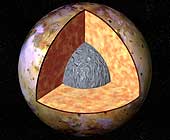On January 7, 1610 Galileo Galilei observed three pinpoints of light strung out in a line next to Jupiter. The next evening, these stars seemed to have moved the wrong way, which caught his attention. Galileo continued to observe the stars and Jupiter for the next week. On January 11, a fourth star (Ganymede) appeared. After a week, Galileo observed that the four stars never left the vicinity of Jupiter, appeared to be carried along with the planet, and changed their position with respect to each other and Jupiter. Finally, Galileo determined that what he was observing were not stars, but planetary bodies that were in orbit around Jupiter. This discovery provided evidence in support of the still heretical Copernican solar system and showed that everything did not revolve around the Earth.
In 1676 a Danish astronomer Ole Romer was able to make the first accurate measurement of the speed of light by using eclipse timings of the Galilean satellites with Jupiter's shadow. Another discovery was made by Pierre-Simon de Laplace during the late 1700s when he deduced that the orbital periods of Io, Europa, and Ganymede are nearly in a perfect 1:2:4 ratio. In 1920 this knowledge paved the way for the first estimate of the satellites' masses within an accuracy of 20%. Finally in 1979, the Voyager spacecraft flew past the Jovian system, took high-resolution pictures of the moons, and conducted experiments that provided the first accurate measurements of the moon's dimensions and mass. These in turn were used to calculate the mean density of Io (3.5 g/cm3), Europa (3.0 g/cm3), Ganymede (1.9 g/cm3), and Callisto (1.8 g/cm3).
Based on density, surface composition analysis, and gravity data, Io appears to be a rocky silicate rich body that has a dense iron, iron sulfide core that extends halfway to the surface with a partially melted silicate rich mantle, and a thin rocky crust. The lower density of Ganymede and Callisto suggest that they are composed of lighter elements, most likely water in some form. Why are there such differences among the four Galilean satellites? During the early formation of the solar sys Left: This cutaway illustration shows the possible internal structure of Io. The interior characteristics of the moon are inferred from gravity field and magnetic field measurements by the Galileo spacecraft. Io has a metallic (iron, nickel) core (shown in gray) drawn to the correct relative size. The core is surrounded by a rock shell (shown in brown). Io's rock or silicate shell extends to the surface. [more]
Left: This cutaway illustration shows the possible internal structure of Io. The interior characteristics of the moon are inferred from gravity field and magnetic field measurements by the Galileo spacecraft. Io has a metallic (iron, nickel) core (shown in gray) drawn to the correct relative size. The core is surrounded by a rock shell (shown in brown). Io's rock or silicate shell extends to the surface. [more]
Tidak ada komentar:
Posting Komentar